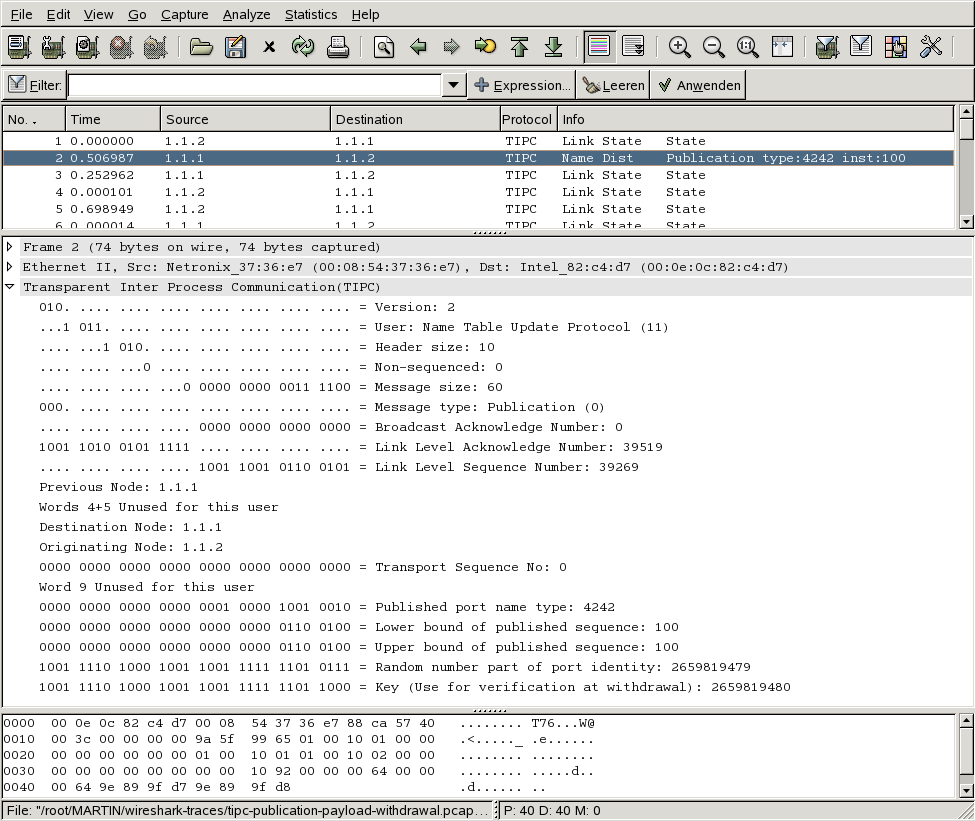Transparent Inter Process Communication (TIPC)
History
The TIPC protocol originated at the telecommunications manufacturer Ericsson, and has been deployed in their products for years; it has been released to the Open Source community. So far TIPC is available for Linux and VxWorks. An OpenSolaris implementation is work in progress.
Protocol dependencies
-
Ethernet: For now, TIPC uses Ethernet as its transport protocol. The ethertype 0x88ca is assigned by IEEE. Other transport protocols are possible and might be implemented.
-
TCP: A TIPC bearer using TCP as its transport protocol is work-in-progress.
Example traffic
Wireshark
The TIPC dissector is fully functional but could be improved for sure:
- Improve info column
- Use conversations
Preference Settings
- Reassemble TIPCv1 SEGMENTATION_MANAGER datagrams
- Dissect TIPC data
- Try heuristic subdissectors first
- Handle version 2 as ALL or TIPC1.5/1.6 or TIPC1.7 As TIPC1.5/1.6 and TIPC1.7 both use version 2 but have differing layout in some message, one can choose here if the dissector shall show a superset of the message fields (ALL) or just the ones active in the respective TIPC version.
Example capture files
Display Filter
A complete list of TIPC display filter fields can be found in the display filter reference
Show only the TIPC based traffic:
tipc Capture Filter
Capture TIPC traffic only:
ether proto 0x88ca Making subdissectors
The determination of the right Port Name Type ("tipcv2.port_name_type") for all messages is not implemented yet because it is not explicily set in every message (see above for more information).
If you're only running one sub-protocol in your TIPC network it might be sufficient if you're just using the TIPC User ("tipc.usr") to trigger your dissector when it's a message containing data (this field is the TIPC IMPORTANCE value).
So, the most easiest way is to substitute "tcp.port" or "udp.port" (in most of examples on how to make your own dissector) with ("tipc.usr") and the port with the message IMPORTANCE you're using to send your data. You can also use more than one hook if you don't know the message IMPORTANCE in advance or are using different ones.
Possible values are:
TIPC_IMPORTANCE_LOW 0
TIPC_IMPORTANCE_MEDIUM (Normal) 1
TIPC_IMPORTANCE_HIGH 2
TIPC_IMPORTANCE_CRITICAL (NonRejectable) 3Alternatively you can determine with heuristics ("tipc") if a message's data contains your protocol.
If you're having more than one sub-protocol, it will be better to determine a clear way to distinguish them and implement heuristics.
Why can't I attach a dissector to a TIPC port name?
On the tipc-discussion mailinglist, Allan Stephens described where the Port Name is not set with the following words:
The "named" and "mcast" message types have info in the TIPC header to
specify the message's destination (a port name and port name sequence,
respectively); these message types typically occur when an application
sends connectionless traffic. The "conn" type is used to carry
connection-oriented traffic over an already established connection;
since the sending socket/port already knows the port ID of the other end
of the connection, there is no need for any port name information to be
present in the TIPC header.
The "direct" type is used to carry connectionless traffic to a
destination that was specified using a port ID, rather than a port name;
again, no port name info is present in the TIPC header because it is not
required. Situations where this sort of message might be generated
include: a) an application obtains a port ID as part of a subscription
event generated by TIPC's topology server and then sends a message to
that port ID (using sendto() or sendmsg()), and b) a server obtains a
client's port ID when it receives a message from the client (using
recvfrom() or recvmsg()) and then sends a reply back to that client port
ID (using sendto() or sendmsg()).Example
Here is a simple example in LUA (based on Lua/Dissectors):
-- trivial protocol example
-- declare our protocol
trivial_proto = Proto("trivial","TRIVIAL","Trivial Protocol")
-- create a function to dissect it
function trivial_proto.dissector(buffer,pinfo,tree)
pinfo.cols.protocol = "TRIVIAL"
local subtree = tree:add(trivial_proto,buffer(),"Trivial Protocol Data")
subtree:add_le(buffer(0,2),"The first two bytes: " .. buffer(0,2):le_uint())
subtree = subtree:add(buffer(2,2),"The next two bytes")
subtree:add_le(buffer(2,1),"The 3rd byte: " .. buffer(2,1):le_uint())
subtree:add_le(buffer(3,1),"The 4th byte: " .. buffer(3,1):le_uint())
end
-- load the tipc.usr (TIPC importance) table
tipc_table = DissectorTable.get("tipc.usr")
-- register our protocol to all the 4 importance
tipc_table:add(0,trivial_proto)
tipc_table:add(1,trivial_proto)
tipc_table:add(2,trivial_proto)
tipc_table:add(3,trivial_proto)Note on endianess
The example uses subtree:add_le() and buffer(offset,len):le_uint() to ilustrate messages in Little Endian (host byte order on a x86 architecture), because its common to use host byte order for TIPC messaging. The default (subtree:add() and buffer(offset,len):uint() interpret the bytes as Big Endian).
External links
-
http://tipc.sourceforge.net/ TIPC Project Homepage - Documentation, Download and Support.
-
http://linux-net.osdl.org/index.php/TIPC TIPC FAQ.
-
http://www.multicore-association.org/workgroup/TIPC.html TIPC working group of the Multicore Association oversees the evolution of the TIPC protocol.
Discussion
Imported from https://wiki.wireshark.org/TIPC on 2020-08-11 23:26:40 UTC

